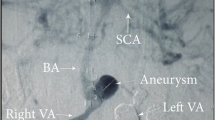Summary
Fourteen cases of midline vertebro-basilar trunk aneurysms were operated on by four routes of surgical approach: middle fossa anterior transpetrosal approach (ATP), presigmoid transpetrosal approach (PTP), conventional lateral suboccipital approach (LSO) or suboccipital transcondylar approach (STC). There was no mortality, but the morbitity was different depending on the surgical approach. In basilar trunk aneurysms located higher than the internal auditory canal, excellent results were obtainable by ATP, especially in the case of posteriorly projecting aneurysms. For midline vertebral aneurysms located lower than the internal auditory canal, STC resulted in less surgical complications than LSO. Extradural resection of the jugular tubercle was necessary for aneurysms located on the distal vertebral artery at or close to the vertebro-basilar junction. For vertebro-basilar junction aneurysms located at the level of the internal auditory canal, hearing was preserved by STC, but not by ATP or PTP. However, choice of the surgical approach may depend on the direction of the aneurysm and the technical accessibility of the skull base. All these skull base approaches reduced surgical complications of retraction damage to the cranial nerves and the brain stem. This holds true for all aneurysms arising from the midline vertebro-basilar trunk.
Similar content being viewed by others
References
Bertalanffy H, Seeger W (1991) The dorsolateral, suboccipital, transcondylar approach to the lower clivus and anterior portion of the craniocervical junction. Neurosurgery 29: 815–821
Crockard HA, Kousei T, Watkin N (1991) Transoral transclival clipping of anterior inferior cerebellar artery aneurysm using new rotating applier. Technical note. J Neurosurg 75: 483–485
Drake CG (1978) The treatment of aneurysms of the posterior circulation. Clin Neurosurg 26: 96–144
Fox JL (1967) Obliteration of midline vertebral artery aneurysm via basilar craniotomy. J Neurosurg 26: 406–412
George B, Dematons C, Cophigton J (1988) Lateral approach to the anterior portion of the foramen magnum. Surg Neurol 29: 484–490
Hakuba A, Nishimura S, Jang BJ (1988) A combined retro-auricular and preauricular transpetrosal transtentorial approach to clivus mengingiomas. Surg Neurol 30: 108–116
Hashi K, Hakuba A, Ikuno H (1976) A midline vertebral artery aneurysm operated via transoral transclival approach. No Shinkei Geka 4: 183–189
Heros RC (1991) The far lateral inferior suboccipital approach. In: Wilkins RH, Rengachary SS (eds) Neurosurgery. Update II. McGraw-Hill, New York, pp 106–109
Jamieson KG (1968) Aneurysms of the vertebrobasilar system. Further experience with nine cases. J Neursosurg 28: 544–555
Kawase T, Toya S, Shiobara R, Mine T (1985) Transpetrosal approach for aneurysms of the lower basilar artery. J Neurosurg 63: 857–861
Kawase T, Shiobara R, Toya S (1991) Anterior transtentorial approach for sphenopetroclival meningiomas: surgical method and results in 10 patients. Neurosurgery 28: 869–876
Koos WT, Spetzler RF, Pendle G, Perneczky A, Lang J (1985) Color atlas of microneurosurgery. Thieme, Stuttgart, pp 125–128
Logue V (1964) Posterior fossa aneurysms. Clin Neurosurg 11: 183–219
Los Reyes RA, Kantrowitz AB, Detwiler PW, Feghale JG, Craig CD, Sonstein WJ (1992) Transoral-transclival clipping of a giant lower basilar artery aneurysm. Surg Neurol 1992: 379–382
Peerless SJ, Drake CG (1982) Surgical techniques of posterior cerebral aneurysms. In: Schmiedek HH, Sweet WH (eds) Operative neurosurgical techniques. Indications, methods, and results, Vol 2. Grune and Stratton, New York, pp 909–931
Perneczky A (1986) The posterolateral approach to the foramen magnum. In: Samii M (ed) Surgery in and around the brain stem and the third ventricle. Springer, Berlin Heidelberg New York Tokyo, pp 460–466
Rosenberg SI, Flamm ES, Hoffer E, Schwartz DM (1992) The retrolabyrinthine transsigmoid approach to midbasilar artery aneurysms. Laryngoscope 102: 100–104
Sano K, Jinbo M, Saito I (1966) Verterbro-basilar aneurysms, with special reference to the transpharyngeal approach to basilar artery aneurysm. Brain Nerve 18: 1197–1203 (Jpn)
Sen C, Sekhar LN (1990) An extreme lateral approach to intradural lesions of the cervical spine and foramen magnum. Neurosurgery 27: 197–204
Sen C, Sekhar LN (1991) Surgical management of anteriorly placed lesions at the craniocervical junction: an alternative approach. Acta Neurochir (Wien) 108: 70–77
Uchida K, Kawase T, Takamiya T,et al (1991) Problem of surgical approach to the midline vertebral aneurysms. Surg Cerebral Stroke 19: 391–395 (Jpn)
Author information
Authors and Affiliations
Rights and permissions
About this article
Cite this article
Kawase, T., Bertalanffy, H., Otani, M. et al. Surgical approaches for vertebro-basilar trunk aneurysms located in the midline. Acta neurochir 138, 402–410 (1996). https://doi.org/10.1007/BF01420302
Issue Date:
DOI: https://doi.org/10.1007/BF01420302




